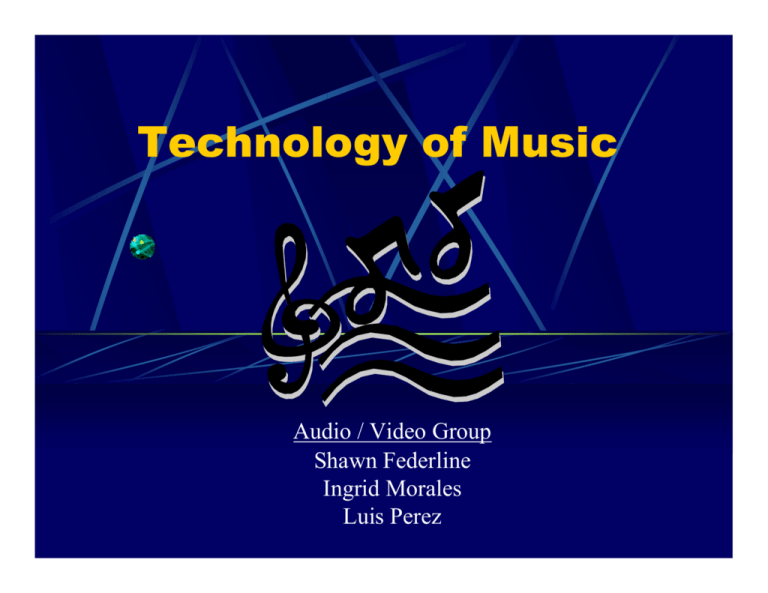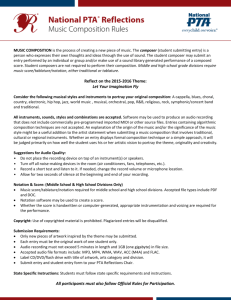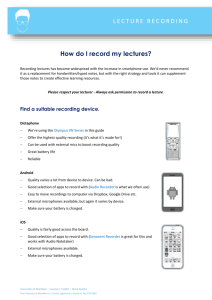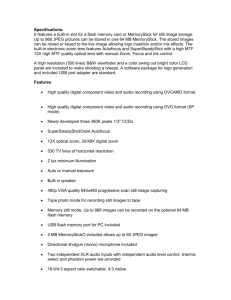Technology of Music Distribution Mediums
advertisement

Technology of Music Audio / Video Group Shawn Federline Ingrid Morales Luis Perez Timeline of Music Technology 1877. Thomas Edison invented the phonograph. 1888. Emile Berliner invented the flat disc record. In 1895, Italy. Guglielmo Marconi and his brother Alfonso first radio transmission. 1897 First Radio Station. 1906 First radio audio Broadcast. 1935, Germany. Begun invents a new technology called "magnetic tape recording." 1948, US. Peter Goldmark invents “Long Plays”. 1960’s FM Radio booms. Timeline of Music Technology (continue) 1983 Introduction of CD’s. 1987, Germany. MP3 technologies created by the Fraunhofer Institute. 1993 Adaptive Transform Acoustic Coding ( ATRAC) invented by Sony engineers. ATRAC compresses compact disc audio to approximately 1/5 of the original data rate with virtually no loss in sound quality. 1995 Internet Radio is possible. 1998. The first digital audio player on the American market: Eiger Labs F10.(32 Meg, $180.00 v.s Mini iPod 4 Gb $199.00) In the late 1990s, MP3 made it feasible to transfer quality audio via the Web in a reasonable amount of time over an analog modem. Timeline of Music Technology (continue) 2001 Satellite Radio. 2001 Apple introduces iPod for Mac. 2002 Apple introduces iPod for Windows. Technology of Music Distribution Mediums Phonograph - Marked to the public in the late 1870’ FM Broadcasts – First commercial US broadcast 1941 Vinyl Records – Late 1940’s LP records and 45’s are introduced. 8 tracks - Appeared in the late 1960’s Cassette tapes - Introduced not long after 8 tracks CD’s - Introduced in the early 1980’s MP3’s - Appeared in the early 1990’s World-Wide Web (WWW) developed in 1991 Phonograph Recorded sound waves onto tinfoil and later wax cylinders Recording time 2 minutes per wax cylinder. Recording and playback was achieved through pure mechanical transference of sound waves. Mass production of phonograph recordings was not efficient. Each recording had to be made with the musician. Sound quality deteriorated with use. Vinyl Records Recorded sound waves onto flat, circular vinyl discs. Recording time ranged from 3 to 30 minutes per side. Recording and playback was achieved through mechanical means, however electronic circuits such as amplifiers and piezo-electric styluses allowed for higher sound quality and an increase in volume control. Mass production of records was achieved through record presses. Sound quality deteriorated with use. Record players were not easily portable. FM RADIO Sound waves are encoded into a FM (Frequency Modulation) carrier signal which is broadcast to receivers tuned to that frequency . FM receivers are smaller and more portable than record players. Radio receivers are less sensitive to vibration than record players . One radio station can broadcast songs to many people at the same time. 8 Tracks Recorded sound waves electronically by creating a magnetic field on a thin magnetic tape. Allowed recording of 4 songs, that were quickly accessible. Playback and recording was now processed through electronic circuits and the use of magnetic fields. Mass production of 8 tracks was much more efficient. Dubs could be made electronically from 1 master tape to many 8 track cassettes. 8 track players were installed in cars and allowed people to take their music with them. Cassette tapes Recorded sound waves electronically by creating a magnetic field on a thin magnetic tape. Allowed recording of more songs than 8 tracks. Playback and recording was processed through electronic circuits and the use of magnetic fields. Mass production of cassette tapes like that of 8 tracks was also more efficient. Dubs could be made electronically from 1 master tape to many cassettes tapes. Cassette tapes were much smaller than 8 tracks and allowed for more compact players that could be carried with you. CD’s (Compact Disk) Digitally recorded sounds are written and read as “wave” files by a laser off of a thin layer of aluminum inside a small plastic disc. Allows recording of 80 minutes of uncompressed music. Playback and recording is processed through digital circuits and the use of laser optic devices. CD Mass production produces exact copies of the original master. CD’s are durable, portable, and do not loose sound quality over time. Sound quality is far superior to that of vinyl records and tape cassettes. MP3’s (MPEG Audio layer-3) Digitally recorded sounds are compressed to a smaller file size known as MP3. MP3 files are stored on computer hard drives, memory cards, or CDs. MP3 files do not deteriorate from time or usage. Playback and recording is processed through digital devices, such as computers and portable MP3 players. Because the files are a compressed version of the original wave file the sound quality is technically not as good as a wave file but the average person cannot tell the difference. World-Wide Web Began as a networking project at a research center called CERN Computers networked together all around the world. Provides immediate access to information, games, and multimedia. Allows sharing of information from one computer to another through downloading and uploading of files. The advent of Napster and other file sharing programs forced the Music Industry to take notice. There are now numerous sites where music can be legally downloaded. This allows for instant music purchases. Music Technology for the Musician (1960’s) For musicians recording was a very expensive process. In the 1960’ they had analog equipment that would record in tape. John Avison conducting the CBC Vancouver Orchestra in the tracking room in Aragon Studios in the 1960’s. Music Technology for the Musician (1970’s) In the 1970’s most of the musicians recording were Rock Bands, using 16-track Audio consoles. Music Technology for the Musician (1980’s) Then in the 1980’s bigger consoles with 24-32 tracks of audio were built. We can see how better equipment started to develop. Music Technology for the Musician (Now) In the 1990’s many different kinds equipment were build and refined: compressor, limiters, gates, etc. Now days, most consoles on professional studio are digital consoles. Music Recording for the Home Studio Now a days, Personal computers have become more powerful, more affordable, and easier to use. It is now possible to perform the entire music production process inside a computer system. You can now purchase a ready-to-use audio computer system, purpose-built and expertly configured and tested for music and audio production. The computer can record and replay your audio data; then it can let you manipulate and polish the sound. Music Recording for the Home Studio (continue) Performing the entire recording and composition process in the computer is highly efficient and it maximizes productivity. It also makes it quite easy to preserve excellent sound quality throughout the process. You can easily burn a CD, on your computer, directly from your computer composition — keeping the pristine sound quality. There are many Audio Editing Software that are affordable to the everyday musician. These have powerful sets of audio processes, tools, and effects for manipulating of audio data. These features will allow you to view, edit, record, modify, encode, and master nearly any form of digital audio. Music Recording for the Home Studio (continue) Examples of such audio computer application software are Digidesign Pro Tools, Sony Acid, Cakewalk Sonar. In my case I own Pro Tools. Conclusion The Music Technology has developed in a way that helps the person that listens to music and the one that makes music. And we believe that it will keep on advancing parallel to how technology is advancing. Questions?







